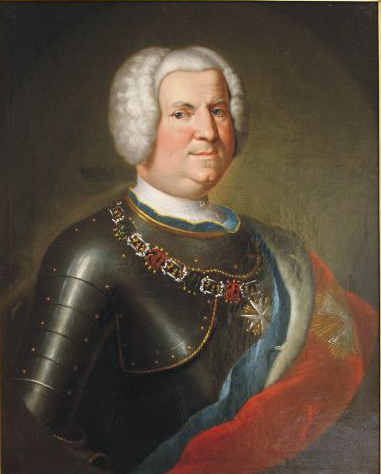by Susan Flantzer
Principality of Schwarzburg-Sondershausen: The County of Schwarzburg was a state of the Holy Roman Empire from 1195 to 1595, when it was partitioned into Schwarzburg-Rudolstadt and Schwarzburg-Sondershausen. The new counties remained in the Holy Roman Empire until its dissolution. In 1697, the County of Schwarzburg-Sondershausen was elevated to the Principality of Schwarzburg-Sondershausen. The County of Schwarzburg-Rudolstadt was elevated to the Principality of Schwarzburg-Rudolstadt in 1710.
The death of Karl Günther, Prince of Schwarzburg-Sondershausen without an heir in 1909 caused the Principalities of Schwarzburg-Rudolstadt and Schwarzburg-Sondershausen to be united under Günther Victor, Prince of Schwarzburg-Rudolstadt in a personal union. Following his succession in Sondershausen, Prince Günther Victor dropped the name Rudolstadt from his title and assumed the title Prince of Schwarzburg.
At the end of World War I, Prince Günther Victor was the last German prince to renounce his throne, abdicating on November 22, 1918. He made an agreement with the government that awarded him an annual pension and the right to use several of the family residences. The territory that encompassed the Principalities of Schwarzburg-Rudolstadt and Schwarzburg-Sondershausen is now located in the German state of Thuringia.
*********************

Credit – Wikipedia
Günther Friedrich Karl I, Prince of Schwarzburg-Sondershausen was born on December 5, 1760, in Sondershausen, Principality of Schwarzburg-Sondershausen, now in the German state of Thuringia. He was the eldest of the four sons and the six children of Christian Günther III, Prince of Schwarzburg-Sondershausen and Charlotte Wilhelmine of Anhalt-Bernburg.
Günther Friedrich Karl I had five younger siblings:
- Catharina (1761 – 1801), married Prince Friedrich of Schwarzburg-Sondershausen, had one child Guntherina of Schwarzburg-Sondershausen who married her uncle (see below)
- Günther Albrecht (1767 – 1833), unmarried
- Caroline Auguste (1769 – 1819), Deaness of the Protestant Herford Abbey
- Albertine (1771 – 1829), married Duke Ferdinand of Württemberg, divorced, no children
- Johann (1772 – 1842), married his niece Guntherina of Schwarzburg-Sondershausen, had four children
On June 23, 1799, Günther Friedrich Karl I married Caroline of Schwarzburg-Rudolstadt (1774–1854). She was the daughter of Friedrich Karl, reigning Prince of Schwarzburg-Rudolstadt and Friederike of Schwarzburg-Rudolstadt.
Günther Friedrich Karl I and Caroline had two children:
- Princess Emilie of Schwarzburg-Sondershausen (1800 – 1867), married Prince Leopold II of Lippe, had nine children
- Günther Friedrich Karl II, Prince of Schwarzburg-Sondershausen (1801 – 1889), married (1) Caroline of Schwarzburg-Rudolstadt, had four children (2) Mathilde of Hohenlohe-Öhringen, had two children
Upon the death of his father Christian Günther III on October 14, 1794, Günther Friedrich Karl became the reigning Prince of Schwarzburg-Sondershausen. During his reign, the Holy Roman Empire, the institution that held the German monarchies together, collapsed. His reign also saw the rise and fall of Napoleon Bonaparte. In 1807, Schwarzburg-Sondershausen joined the Confederation of the Rhine, a confederation of the client states of Napoleon’s First French Empire, and was under the protection of Napoleon until 1813. In 1815, the Principality of Schwarzburg-Sondershausen joined the German Confederation, an association of 39 predominantly German-speaking sovereign states in Central Europe, created by the Congress of Vienna in 1815 as a replacement of the former Holy Roman Empire, which had been dissolved in 1806.
Günther Friedrich Karl I promoted the arts in his principality. He built a theater in Sondershausen and continued the princely patronage of the Loh Orchestra Sondershausen (link in German), first established circa 1600, and still in existence.
Günther Friedrich Karl I ruled as an absolute monarch despite his subjects wanting a say in the principality’s government. His refusal to grant any concessions made him very unpopular and he was forced to abdicate on August 19, 1835, by his son Günther Friedrich Karl II in a palace revolt called the Ebeleben Revolution.

Jagdschloss zum Possen; Credit – Von Krajo – Eigenes Werk, CC BY-SA 3.0, https://commons.wikimedia.org/w/index.php?curid=1754158
Günther Friedrich Karl I lived out the rest of his life at his hunting lodge Jagdschloss zum Possen (Hunting Castle of Antics – link in German) near Sondershausen. He died there on April 22, 1837, aged 77, and was buried in Ebeleben, Principality of Schwarzburg-Sondershausen, now in the German state of Thuringia. His exact burial site is unknown but it could have been Schloss Ebeleben (link in German). However, during World War II, the castle buildings were destroyed and the ruins were later removed.
His wife Caroline survived him by seventeen years, dying in 1854. She was buried at Fürstengruft auf dem Alten Friedhof (Princely Crypt at the Old Cemetery) in Arnstadt, Principality of Schwarzburg-Sondershausen, now in the German state of Thuringia.
This article is the intellectual property of Unofficial Royalty and is NOT TO BE COPIED, EDITED, OR POSTED IN ANY FORM ON ANOTHER WEBSITE under any circumstances. It is permissible to use a link that directs to Unofficial Royalty.
Schwarzburg-Sondershausen Resources at Unofficial Royalty
- Unofficial Royalty: Principality of Schwarzburg-Sondershausen Index
- Unofficial Royalty: Royal Burial Sites of the Principality of Schwarzburg-Sondershausen
Works Cited
- De.wikipedia.org. 2020. Günther Friedrich Carl I. (Schwarzburg-Sondershausen). [online] Available at: <https://de.wikipedia.org/wiki/G%C3%BCnther_Friedrich_Carl_I._(Schwarzburg-Sondershausen)> [Accessed 12 November 2020].
- Flantzer, Susan, 2020. Royal Burial Sites Of The Principality Of Schwarzburg-Sondershausen. [online] Unofficial Royalty. Available at: <https://www.unofficialroyalty.com/royal-burial-sites/german-royal-burial-sites/royal-burial-sites-of-the-principality-of-schwarzburg-sondershausen/> [Accessed 9 November 2020].


























